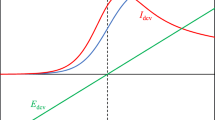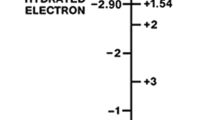Abstract
The polarisation impedance of the platinum electrode was measured in physiological saline (0·9% NaCl) over six decades of frequencies down to 1 mHz. The applicability, of Fricke’s phase angle rule was verified down to 10 mHz. The resistive shunt which emerges at lower frequencies was shown to be equivalent to the direct current (d.c.) impedance of the interface. A Cole-Cole (1941) type of relaxation model is proposed to describe the interface behaviour over all frequency ranges. Nonlinear polarisation measurments have demonstrated the validity of Schwan’s limit law of linearity at very low frequencies.
Similar content being viewed by others
References
Almasi, J. J., Hart, M. W. andSchmitt, O. H. (1968) On-line measurement of biological impedance at very low frequencies.Biophys. J.,8, A45.
Almasi, J. J. andSchmitt, O. H. (1974) Automated measurement of bioelectric impedance at very low frequencies.Comp. Biomed. Res.,7, 449.
Armstrong, R. D., Bell, M. F. andMetcalfe, A. A. (1977) A method for automatic impedance measurement and analysis.J. Electroanal. Chem.,77, 287.
Bockris, J. O’M., Gileadi, E. andMüller, K. (1966) Dielectric relaxation in the electric double layer.J. Chem. Phys. 44, 1, 1445.
Boer, R. W. de andvan Oosterom, A. (1978) Electrical properties of platinum electrodes: impedance measurements and time domain analysis.Med. & Biol. Eng. & Comput.,16, 1–10.
Burbank, D. P. andWebster, J. G. (1978) Reducing skin potential motion artefact by skin abrasion.Med. & Biol. Eng. & Comput.,16, 31–38.
Cole, K. S. andCole, R. H. (1941) Dispersion and absorption in dielectrics. I. Alternating current characteristics.J. Chem. Phys.,9, 341.
Daniel, V. V. (1967)Dielectric relaxation. Academic Press, New York, London.
Dymond, A. (1976) Characteristics of the metal-tissue interface of stimulation electrodes.IEEE Trans.,BME23, 4, 274.
Epelboin, I., Gabrielli, C. andLestrade, J. C. (1970) Etude et réalization d’un potentiostat destiné aux mesures d’impédance électrochimique entre 10−5 et 50 kHz.Revue Générale de l’Electricité,79, 669.
Epelboin, I., Keddam, M. andLestrade, J. C. (1973) Faradaic impedances and intermediates in electrochemical reactions.Faraday Discuss. Chem. Soc.,56, 264.
Fricke, H. (1932) The theory of electrolytic polarisation.Philo. Mag.,14, 310.
Gabrielli, C. andKeddam, M. (1974) Progrès récent dans la mesure des impédances electrochimiques en régime sinusoidal.Electrochimica Acta,19, 355.
Gabrielli, C., Ksouri, M. andWiart, R. (1977) Compensation de la chute ohmique par une méthode analogique. Application a la mesure des impédances electrochimiques et à la détermination des courbes de polarization.Electrochimica Acta,22, 255.
Geddes, L. A., da Costa, C. P. andWise, G. (1971) The impedance of stainless-steel electrodes.Med. & Biol. Eng.,9, 511.
Grahame, D. C. (1946) Properties of the electrical double layer at a mercury surface. II. The effect of frequency on the capacity and resistance of ideally polarized electrodes.J. Am. Chem. Soc.,68, 301.
Grahame, D. C. (1952) Mathematical theory of faradaic admittance.J. Electrochem. Soc.,99, 370c.
Greef, R. (1978) Instruments for use in electrode process research.J. Phys. E.: Sci. Instrum.,11, 1.
Jaron, D., Schwan, H. P. andGeselowitz, D. B. (1968) A mathematical model for the polarization impedance of cardiac pacemaker electrodes.Med. & Biol. Eng.,6, 579.
Kahn, A. andGreatbatch, W. (1974) Physiological electrodes. InMedical engineering,Ray, C. D. (Ed.) Year Book Med. Publ.
McDonald, J. R. (1971) Electrical response of materials containing space charge with discharge at the electrodes.J. Chem. Phys.,54, 2026.
Mohilner, D. M., Kreuser, J. C., Nakadomari, H. andMohilner, P. R. (1976) Computer controlled differential capacitance measurements.J. Electrochem. Soc.,123, 359.
Murdock, C. C. andZimmerman, E. E. (1936) Polarization impedance at low frequencies.Physics 7, 211.
Randles, J. E. B. (1947) Kinetics of rapid electrode reactions.Disc. Faraday Soc.,1, 11.
Scheider, W. (1977) Real-time measurement of dielectric relaxation of biomolecules: kinetics of a protein-ligand binding reaction.Ann. N.Y. Acad. Sci.,303, 47.
Schwan, H. P. (1963) Determination of biological impedances. InPhysical techniques in biological research (Vol. 6).Nastuk, W. L. (Ed.). Academic Press, New York, 323–407.
Schwan, H. P. andMaczuk, J. G. (1965) Electrode polarization impedance: limits of linearity.Proc. 18th Ann. Conf. Eng. Biol. Med.,5, 24.
Schwan, H. P. (1966) Alternating current electrode polarisation.Biophysik,3, 181.
Schwan, H. P. (1968) Electrode polarisation impedance and measurements in biological materials.Ann. N.Y. Acad. Sci.,148, 191.
Silverman, H. T., Miller, I. F. andSalkind, A. J. (1973)Electrochemical bioscience and bioengineering. Electrochemical Soc., Inc., p. 160, discussion of the paper byPiersma et al.
Simpson, R. W. (1976)Nonlinear electrode polarization impedance. Ph.D. Dissertation, Univ., Pennsylvania.
Simpson, R. W., Berberian, J. G. andSchwan, H. P. (1980) Nonlinear AC and DC Polarization of Platinum Electrodes. IEEE Trans.,BME27, 166–171.
Sluyters-Rehbach, M. andSluyters, J. H. (1970) Sine wave methods in the study of electrode processes.J. Electroanal. Chem.,4, 1.
Timmer, B., Sluyters-Rehbach, M. andSluyters, J. H. (1968) On the impedance of galvanic cells. XXIII. Electrode Reactions with Specific Adsorption of the Electroactive Species: the Pb+2/Pb(Hg) Electrode in M KNO3-KCl Mixtures.J. Electroanal. Chem.,18, 93.
Venkatesh, S. D. andChin, T. (1979) The alternating current electrode processes.Israel. J. Chem.,18, 56.
Warburg, E. (1899) Ueber das Verhalten sogenannter unpolarisirbarer Elektroden gegen Wechselstrom.Ann. Physik. und Chemie,67, 493.
Warburg, E. (1901) Ueber die Polarisations capacität des Platins.Ann. der. Physik.,6, 125.
Author information
Authors and Affiliations
Rights and permissions
About this article
Cite this article
Onaral, B., Schwan, H.P. Linear and nonlinear properties of platinum electrode polarisation. Part 1: frequency dependence at very low frequencies. Med. Biol. Eng. Comput. 20, 299–306 (1982). https://doi.org/10.1007/BF02442796
Received:
Accepted:
Issue Date:
DOI: https://doi.org/10.1007/BF02442796




